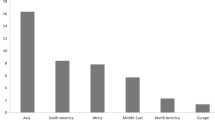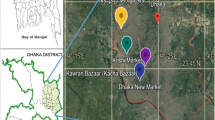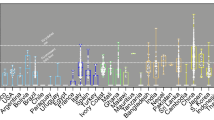Abstract
In an attempt to know whether highly consumed food might contribute to metal exposure, we analyzed cadmium, lead, and mercury in 27 rice grain samples commonly consumed in Saudi Arabia by atomic absorption spectrometry after acid digestion. The mean concentrations and ranges of cadmium, lead, and mercury in tested rice samples were 20.261 (range <DL-178.026 µg/kg), 134.819 (range 23.1–1529.0 µg/kg), and 3.186 (range <DL-43.573 µg/kg), respectively. The results showed high concentrations of metals and in some cases exceeded the Provisional Tolerance Weekly Intake (PTWI) recommended by FAO/WHO. It was also noted that different rice grain samples had varying concentrations of these metals. Because the bulk of literature warns against the cumulative effects of prolonged heavy metal exposure, regular consumption of rice by local populations might pose potential health problems.
Similar content being viewed by others
References
S. B. Sterrett, R. L. Chaney, C. H. Gifford, and H. W. Mielke, Influence of fertilizer and sewage sludge compost on yield and heavy metal accumulation by lettuce grown in urban soils, Environ. Geochem. Health 18, 135–142 (1996).
T. C. Herrero and F. L. Martin, Evaluation of cadmium levels in fertilized soils, Bull. Environ. Contam. Toxicol. 50, 61–68 (1993).
G. Gupta and S. Charles, Trace elements in soils fertilized with poultry litter, Poul. Sci. 78, 1695–1698 (1999).
M. D. Taylor, Accumulation of cadmium derived from fertilizers in New Zealand soils, Sci. Total Environ. 208, 123–126 (1997).
H. W. Mielke and P. L. Reagan, Soil is an important pathway of human lead exposure, Environ. Health Perpect. 106(Suppl. 1), 217–229 (1998).
M. Schuhmacher, J. Batista, J. L. Domingo, and J. Corbella, Mercury concentrations in autopsy tissues from inhabitants of Tarragona Province, Spain, Trace Elements Elect. 13, 75–79 (1996).
R. Nakagawa and Y. Yumita, Change and behaviour of residual mercury in paddy soils and rice of Japan, Chemosphere 37, 1483–1487 (1998).
T. Watanabe, A. Koizumi, H. Fujita, M. Kumai, and M. Ikeda, Role of rice in dietary cadmium intake of farming population with no known man-made pollution in Japan, Tohoku J. Exp. Med. 114, 83–90 (1984).
C. S. Moon, Z. W. Zhang, S. Shimbo, T. Watanabe, D. H. Moon, C. U. Lee, et al., Dietary intake of cadmium and lead among the general population in Korea, Environ. Res. 71, 46–54 (1995).
Z. W. Zhang, R. D. Subida, M. G. Agetano, H. Nakatsuka, N. Inoguch, T. Watanabe, et al., Non-occupational exposure of adult women in Manila, the Philippines to lead and cadmium, Sci. Total Environ. 215, 157–165 (1998).
Z. W. Zhang, S. Shimbo, T. Watanabe, S. Srianujata, O. Banjong, C. Chitchumrooncokchai, et al., Non-occupational lead and cadmium exposue of adult women in Bangkok, Thailand, Sci. Total Environ. 226, 65–74 (1999).
Z. W. Zhang, C. S. Moon, T. Watanabe, S. Shimbo, F. S. He, Y. Q. Wu, et al., Background exposure of urban populations to lead and cadmium: comparison between China and Japan, Int. Arch. Occup. Environ. Health 69, 273–281 (1997).
S. Muramoto, Heavy metal tolerance of rice plants (Oryza sativa L.) to some metal oxides at the critical levels, J. Environ. Sci. Health 24, 559–568 (1989)
T. Mckenzie, Analytical data for the GTA-96, in Analytical Methods for Graphite Tube Atomizer, E. Rothery, ed., Varian Tectron Pty. Ltd., Milgrave, Victoria, Australia (1988).
Annual Marketing Plan, Market Information Report, American Embassy, Riyadh, Saudi Arabia 62 Post Report Sequence Number: 004 (1996).
M. Schuhmacher, J. L. Domingo, J. M. Llobet, and J. Corbella, Cadmium, chromium, copper, and zinc in rice and rice field soil from southern Catalonia, Spain, Bull. Environ. Contam. Toxicol. 53, 54–60 (1994).
Z. Zhang, C. Moon, T. Watanabe, S. Shimbo, and M. Ikeda, Contents of pollutant and nutrient elements in rice and wheat grown on the neighboring fields, Biol. Trace Element Res. 57, 39–50 (1997).
M. C. Jung and I. Thornton, Environmental contamination and seasonal variation of metals in soils, plants and waters in paddy fields around a Pb-Zn mine in Korea, Sci. Total Environ. 198, 105–121 (1997).
Minitry of Agriculture Food and Fishery, MAFF UK-1994 total diet study: metals and other elements. Joint Food Safety and Standard Group, Food Surveillance Information Sheet. Number 131 (1997).
Author information
Authors and Affiliations
Rights and permissions
About this article
Cite this article
Al-Saleh, I., Shinwari, N. Report on the levels of cadmium, lead, and mercury in imported rice grain samples. Biol Trace Elem Res 83, 91–96 (2001). https://doi.org/10.1385/BTER:83:1:91
Received:
Accepted:
Issue Date:
DOI: https://doi.org/10.1385/BTER:83:1:91




